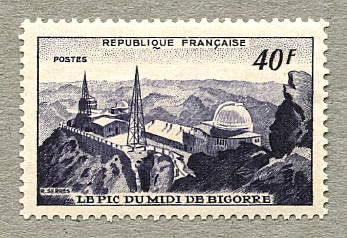France 1951 – Pic du Midi Observatory
Pic du Midi Observatory lies at an altitude of 2860 m in the French Pyrenees, near the border with Spain. It was founded in 1878 primarily for meteorological observations. The first telescope dome, called the Baillaud dome after Benjamin Baillaud, the director of Toulouse Observatory who had it built, was completed in 1908 and a 0.5-m reflector started work there the following year. In 1930 Bernard Lyot installed the first-ever coronagraph, an instrument he invented for observing the outer regions of the Sun, which he mounted on the telescope in the Baillaud dome. In 1963 a 1-m reflector was opened, partly funded by NASA for lunar mapping in preparation for the Apollo landings. The observatory’s largest telescope, a 2-m reflector named after Bernard Lyot, began operation in 1979.
This stamp shows the Pic du Midi Observatory as it appeared around 1950. Right of centre is the Baillaud dome, which by then contained a 0.6-m refractor with a folded optical path; this produced high-resolution images of the planets until the 1960s. Adjoining it, with sloping roof and chimneys, is the Nansouty building, named after the founder of the observatory, which dates to 1878 and was the original living quarters. The two tall pyramids are radio masts erected in 1926 to transmit daily meteorological observations; the base of one still remains and contains meteorological instruments. At the far end, partly hidden by one of the masts, is the Robley dome, which contains a 0.55-m telescope. Between the two aerials is the low Vaussenat building, which also dates from the foundation in 1878; it was used for storage until the 1930s. Above and behind the Vaussenat building is the Gentili dome, which at the time contained a 0.6-m reflector opened in 1947 but since 1963 has housed the 1-m reflector. In the centre foreground, near the foot of one of the radio masts, is a gap where part of the terrace collapsed in 1922.
I am grateful to Emmanuel Davoust for helping me identify the various buildings shown.
SG number
Face value
40 f
Colour
1138
Violet
